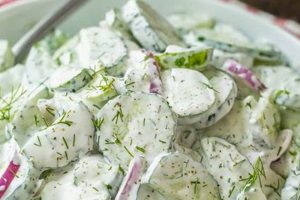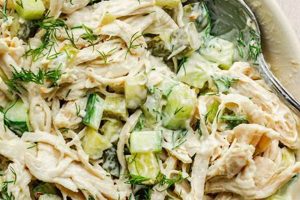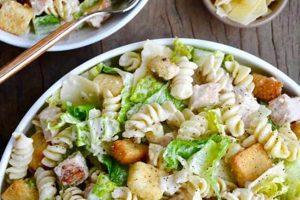A dish typically composed of cooked chicken, mayonnaise, and poppy seeds, this salad often includes additional ingredients such as grapes, celery, onion, and nuts. Variations exist, incorporating different fruits, vegetables, or seasonings to create unique flavor profiles. A simple version might combine shredded chicken with mayonnaise, poppy seeds, and chopped celery, while a more complex iteration could feature grapes, pecans, and a touch of Dijon mustard.
This blend of savory and subtly sweet flavors offers a versatile dish suitable for various occasions. Its ease of preparation makes it ideal for quick lunches, picnics, or potlucks. The protein from the chicken and the healthy fats from the nuts and seeds contribute to a satisfying meal. Historically, the use of poppy seeds in cooking dates back centuries, and their inclusion in chicken salad likely arose as a way to add texture and a distinctive nutty taste. The dish’s popularity has endured, solidifying its place as a classic comfort food.
The following sections will delve into specific variations of this culinary creation, providing detailed recipes and exploring the diverse ways these ingredients can be combined to craft a delicious and satisfying meal.
Tips for an Exceptional Chicken Salad
Achieving optimal flavor and texture requires attention to detail. These tips offer guidance for elevating this classic dish.
Tip 1: Chicken Selection: Opting for high-quality chicken contributes significantly to the overall taste. Rotisserie chicken offers a convenient and flavorful option, while poaching or grilling boneless, skinless breasts provides a leaner alternative. Avoid using pre-cooked, packaged chicken as it can often be dry and lack flavor.
Tip 2: Mayonnaise Matters: Full-fat mayonnaise creates a richer, creamier salad. Consider using a combination of mayonnaise and plain Greek yogurt for a lighter, tangier version. Experiment with flavored mayonnaises, such as lemon or dill, to enhance the flavor profile.
Tip 3: Poppy Seed Proportion: Overdoing the poppy seeds can lead to bitterness. Start with a smaller amount and gradually add more until the desired flavor and texture are achieved. One to two tablespoons per pound of chicken is a good starting point.
Tip 4: Ingredient Freshness: Using fresh, crisp produce enhances both the flavor and visual appeal. Thoroughly wash and dry all fruits and vegetables before incorporating them into the salad.
Tip 5: Balancing Flavors: Achieving a balance of sweet and savory elements is key. The sweetness of grapes or apples complements the savory chicken and the tangy mayonnaise. A touch of acidity, from lemon juice or vinegar, can brighten the flavors.
Tip 6: Texture Considerations: Dicing ingredients into uniform sizes ensures a pleasant eating experience. Avoid over-mixing the salad, as this can result in a mushy texture.
Tip 7: Chilling Time: Allowing the salad to chill in the refrigerator for at least 30 minutes allows the flavors to meld and develop. This also improves the overall texture.
By focusing on these details, one can create a chicken salad that is both flavorful and visually appealing. Attention to ingredient quality, proper proportions, and chilling time significantly impacts the final result.
With these tips in mind, the following section presents several variations on this classic dish, offering a range of flavor profiles and ingredient combinations.
1. Chicken (cooked, shredded)
Cooked, shredded chicken forms the foundation of poppy seed chicken salad. Its preparation and characteristics significantly influence the final dish’s overall quality and flavor profile.
- Cooking Methods:
Various cooking methods yield different results. Rotisserie chicken offers convenience and a flavorful, pre-cooked option. Poaching or boiling produces a moist and tender result, while grilling imparts a smoky char. Baking or pan-frying offer further alternatives, each influencing the chicken’s texture and taste. The chosen method should align with the desired outcome for the salad.
- Shredding Techniques:
Proper shredding ensures optimal texture. Two forks can be used to pull the chicken apart, creating irregular, textured pieces. Alternatively, a stand mixer fitted with a paddle attachment efficiently shreds larger quantities while maintaining a consistent size. The degree of shredding also impacts the final saladfinely shredded chicken results in a smoother texture, while coarser shreds offer more bite.
- Chicken Type:
The specific cut of chicken impacts both flavor and texture. Boneless, skinless breasts provide a lean protein source, while thighs offer a richer, more flavorful option. Using a combination of white and dark meat can create a balanced flavor profile. Pre-cooked, packaged chicken should generally be avoided due to its potential dryness and lack of distinct flavor.
- Flavor Infusion:
The cooking process presents an opportunity to infuse the chicken with additional flavors. Seasoning the chicken before cooking, or incorporating herbs and spices into the cooking liquid, enhances the overall taste. This preemptive flavoring complements the other ingredients in the salad. For example, poaching chicken with bay leaves and peppercorns subtly enhances its flavor, contributing to the final complexity of the salad.
The careful selection and preparation of the chicken contribute significantly to a successful poppy seed chicken salad. The cooking method, shredding technique, and chicken type all play critical roles in determining the final dish’s texture and flavor. Considering these aspects allows for a more deliberate and ultimately satisfying culinary experience.
2. Mayonnaise (base)
Mayonnaise serves as the foundational binding agent in poppy seed chicken salad, contributing significantly to its texture, flavor, and overall success. The quality and type of mayonnaise directly impact the final product. A full-fat mayonnaise creates a richer, creamier salad, while low-fat or fat-free versions can result in a thinner, less flavorful outcome. The mayonnaise also acts as a vehicle for flavor, carrying the subtle notes of the poppy seeds and complementing the other ingredients. For instance, using a mayonnaise enhanced with lemon juice or Dijon mustard adds a layer of complexity, while a plain mayonnaise allows the flavors of the chicken and other components to shine. The amount of mayonnaise used also influences the salad’s consistency, with more mayonnaise producing a creamier result and less resulting in a chunkier texture.
Beyond its functional role as a binder, mayonnaise contributes to the overall sensory experience of the salad. Its creamy texture contrasts with the crunch of celery or nuts, creating a balanced mouthfeel. The subtle tanginess of mayonnaise complements the sweetness of grapes or cranberries, creating a harmonious flavor profile. Furthermore, the emulsified nature of mayonnaise helps to distribute the poppy seeds evenly throughout the salad, ensuring a consistent flavor in every bite. Substituting alternative ingredients, such as plain yogurt or sour cream, while possible, alters the characteristic flavor and texture profile typically associated with this dish. These substitutions, while offering lighter options, often compromise the richness and creaminess provided by mayonnaise.
Understanding mayonnaise’s role as the base allows for informed decisions regarding its selection and application in a poppy seed chicken salad recipe. Careful consideration of the type, quantity, and flavor profile of mayonnaise ensures the creation of a balanced and enjoyable dish. This knowledge facilitates both replicating classic versions and experimenting with innovative variations, ultimately contributing to a successful culinary outcome.
3. Poppy seeds (essential)
Poppy seeds constitute a defining ingredient in poppy seed chicken salad, contributing a unique character that extends beyond mere texture. Their presence introduces a subtle nutty flavor and a delicate crunch, enhancing the complexity of the overall profile. This characteristic crunch offers a textural counterpoint to the creamy mayonnaise and soft chicken, creating a more dynamic sensory experience. Omitting poppy seeds fundamentally alters the dish, transforming it into a standard chicken salad lacking the distinctive element that sets it apart. For instance, consider a version with grapes and pecansthe absence of poppy seeds removes the signature “pop” and diminishes the nuanced flavor profile, even with the other complementary ingredients present. This underscores the essential role of poppy seeds in defining the dish.
Beyond their flavor and texture contributions, poppy seeds offer nutritional benefits. They contain dietary fiber, healthy fats, and trace minerals. While present in relatively small quantities within the salad, these nutritional elements contribute to a more wholesome dish. Furthermore, the visual appeal of poppy seeds speckled throughout the salad enhances its presentation. Their small, black specks create a visual contrast against the lighter background of the chicken and mayonnaise, adding to the overall aesthetic appeal. This visual element, combined with the textural and flavor contributions, elevates poppy seeds from a simple ingredient to a defining characteristic of the dish.
In summary, the inclusion of poppy seeds transforms a basic chicken salad into the distinct culinary creation recognized as poppy seed chicken salad. Their presence is essential not only for the characteristic flavor and textural complexity but also for the nutritional value and visual appeal they bring. Understanding this essentiality allows for a deeper appreciation of the dish and its defining components, ultimately leading to a more informed and satisfying culinary experience. This knowledge empowers one to confidently replicate classic versions and explore innovative variations while preserving the integral role of poppy seeds.
4. Sweetener (grapes, cranberries)
The incorporation of a sweet element, typically grapes or cranberries, plays a crucial role in balancing the flavor profile of poppy seed chicken salad. This sweetness counteracts the savory notes of the chicken and the tanginess of the mayonnaise, creating a harmonious blend. The choice of sweetener influences the overall character of the salad. Grapes contribute a juicy sweetness and a delicate texture, while cranberries offer a tart-sweet flavor and a chewier consistency. This balance prevents the salad from being overly savory or rich, enhancing its palatability. For instance, a salad featuring green grapes offers a lighter, brighter sweetness, while one with dried cranberries provides a more concentrated, intense sweetness, impacting the overall taste experience. This careful balance of sweet and savory elements distinguishes poppy seed chicken salad from other variations.
Beyond simply adding sweetness, the chosen sweetener contributes to the textural complexity of the salad. Grapes, whether halved or quartered, introduce bursts of juiciness, contrasting with the creamy mayonnaise and tender chicken. Cranberries, particularly dried cranberries, offer a chewy texture that provides an interesting counterpoint to the other ingredients. This interplay of textures adds to the overall enjoyment of the dish. The choice between grapes and cranberries, or the inclusion of other sweet elements like chopped apples or mandarin oranges, allows for customization and adaptation to individual preferences. This flexibility expands the possibilities within the basic recipe framework, offering a range of flavor and texture experiences.
In conclusion, the sweet element in poppy seed chicken salad is essential for achieving a balanced and nuanced flavor profile. It is not merely an optional addition but rather a key component that contributes to the dish’s overall success. Understanding the role of sweetness, and the specific characteristics of different sweeteners, enables informed decision-making when preparing this classic dish. This knowledge empowers culinary exploration, allowing for the creation of variations that cater to individual preferences while maintaining the fundamental balance that defines poppy seed chicken salad.
5. Texture (celery, nuts)
Textural contrast contributes significantly to the enjoyment of poppy seed chicken salad. Ingredients like celery and nuts introduce crucial textural variety, enhancing the overall sensory experience. Celery, with its crisp, watery crunch, offers a refreshing counterpoint to the creamy mayonnaise and tender chicken. Nuts, depending on the variety, provide a satisfying crunch and a distinct flavor profile. This interplay of texturescreamy, crunchy, and tenderprevents the salad from becoming monotonous and adds depth to each bite. For instance, the snap of finely diced celery against the smooth backdrop of the mayonnaise-based dressing creates a dynamic textural experience. Similarly, the inclusion of coarsely chopped pecans or walnuts introduces a robust crunch that complements the softer elements of the salad.
The choice of nuts significantly influences not only the texture but also the flavor profile. Walnuts offer a slightly bitter, earthy flavor, while pecans provide a richer, buttery taste. Almonds introduce a subtle sweetness and a firmer crunch. These variations allow for customization based on individual preferences and desired flavor profiles. Furthermore, toasting the nuts before incorporating them into the salad enhances their flavor and intensifies their crunch. This extra step elevates the overall sensory experience, adding a depth of flavor that complements the other ingredients. The quantity of celery and nuts also requires consideration. Too much celery can make the salad watery, while an overabundance of nuts can overpower the other flavors and create an overly dense texture.
In summary, the strategic inclusion of textural elements like celery and nuts elevates poppy seed chicken salad from a simple mixture to a more complex and satisfying culinary experience. The interplay of textures adds depth and interest, while the careful selection and preparation of these ingredients further enhance the overall flavor profile. Understanding the importance of textural contrast, and the specific contributions of celery and nuts, allows for a more informed and nuanced approach to preparing this classic dish. This awareness facilitates both the replication of traditional recipes and the exploration of innovative variations tailored to individual preferences.
Frequently Asked Questions
This section addresses common inquiries regarding poppy seed chicken salad preparation and variations.
Question 1: What is the best type of chicken to use?
Rotisserie chicken offers convenience and flavor, while poached or grilled chicken breasts provide a leaner option. Pre-cooked, packaged chicken is generally less desirable due to its potential dryness.
Question 2: Can the mayonnaise be substituted?
While plain Greek yogurt or sour cream can be used for a lighter version, they alter the characteristic richness and creaminess provided by mayonnaise.
Question 3: How much poppy seed should be used?
Start with one to two tablespoons of poppy seeds per pound of chicken and adjust to taste. Excessive poppy seeds can introduce bitterness.
Question 4: What other ingredients can be added?
Common additions include grapes, celery, apples, cranberries, pecans, walnuts, and almonds. Variations can incorporate water chestnuts, red onion, or dried fruit.
Question 5: How long can poppy seed chicken salad be stored?
Refrigerate for up to three days in an airtight container. Freezing is not recommended, as it can negatively impact the texture.
Question 6: How can the flavor profile be adjusted?
Incorporating lemon juice, Dijon mustard, curry powder, or fresh herbs can enhance and customize the flavor. Consider adding a pinch of salt and freshly ground black pepper to balance the flavors.
Understanding these key aspects of preparation and storage ensures a successful and enjoyable culinary experience. Proper ingredient selection, balanced flavor profiles, and appropriate storage methods contribute significantly to the quality and taste of the final product.
The next section explores various serving suggestions and accompaniments to complement poppy seed chicken salad.
Poppy Seed Chicken Salad Recipe
This exploration of poppy seed chicken salad recipes has delved into the essential components and techniques that contribute to a successful dish. From the selection and preparation of the chicken to the nuanced role of mayonnaise, poppy seeds, sweeteners, and textural elements, each ingredient’s contribution to the final product has been examined. The balance of flavors and textures, achieved through careful ingredient selection and thoughtful preparation, defines this classic dish. Proper storage practices and potential variations further enhance the versatility and appeal of poppy seed chicken salad, solidifying its place as a culinary staple.
Culinary traditions evolve through continued exploration and adaptation. Encouraging experimentation with different ingredients and flavor profiles allows for the discovery of innovative variations while preserving the fundamental elements that define poppy seed chicken salad. An understanding of these core principles empowers culinary creativity, leading to a richer and more diverse appreciation of this timeless dish.






